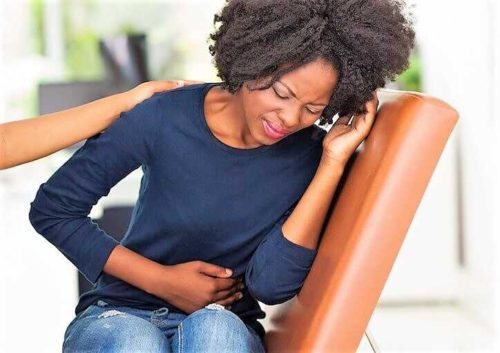Carol Johnson Clark, 57, has had uterine fibroids since the age of 24. The non-cancerous growths never bothered her. When she gave birth, the fibroids grew a little during the process, but still, she felt no pain or discomfort from them. During the past year, however, Carol’s fibroids have not only enlarged but have become painful. “Now, after so many years later, I am facing a hysterectomy because these fibroids are out of control! I thought that since I was menopausal, the fibroids were supposed to go away, boy, was I dead wrong!”
What are uterine fibroids?
As many as 80 percent of women will have leiomyoma or myoma, most commonly known as uterine fibroids by age 50. The non-cancerous growths made of smooth muscle cells and tissue develop within the walls of the uterus. They can grow as a single tumor or a cluster. Fibroids can also vary in size from about the size of a grape to the size of a large melon. Larger fibroids can cause a woman’s uterus to expand and to resemble a 7-month pregnancy.
What are the symptoms of uterine fibroids?
Many women do complain about discomfort or sometimes painful symptoms that are brought on by the fibroids such as:
Lower back pain
Painful sex
Constipation/rectal pain
Frequent urination
A sense of fullness or pain in the abdominal area
Heavy bleeding, clotting or painful periods
Reproductive issues (infertility, multiple miscarriages, early labor, C-section)
There are also women whose fibroids do not present any issues at all.
Who is at risk for uterine fibroids?
Fibroids typically affects women between the ages of 25 to 44. African American women are more likely to have multiple, larger, and more symptomatic fibroids at an earlier age than their Caucasian counterparts and also tend to wait longer to seek a diagnosis.
Many women who suffer from fibroids are under the impression that these tumors will automatically shrink during menopause. According to research, fibroids are more likely to decrease in size in postmenopausal caucasian women than in premenopausal Black women.
What are the risk factors of fibroids?
Being age 40 and up
Being African American
Menstruating at a young age
Overweight
Heredity
Hypertension
Having no history of pregnancy
Low vitamin D levels
What lowers the risk of fibroids?
Pregnancy (the risk gets lower with each pregnancy)
Long-term use of progestin-only birth control pills or oral contraception
Use of the birth control shot (depot medroxyprogesterone acetate [DMPA], or Depo-Provera)
What causes uterine fibroids?
Medical researchers have no clue as to the causes of uterine fibroids, there are assumptions but nothing concrete.
Over the years, clinicians have guessed as to what can cause these growths and have speculated on the following:
Progesterone
Estrogen
Growth hormones
Genetics
Vitamin D deficiency
Stresses
What are the complications of uterine fibroids?
Women who have fibroids may experience heavy bleeding that is unusual while they are menstruating that can lead to anemia. Women of childbearing age may experience pregnancy complications and delivery risks. Fibroids may also block fallopian tubes. Women can experience heavy bleeding and pelvic pain upon giving birth that can require surgery. Fibroids growing along the inner uterine wall may make it difficult for a fertilized egg to attach.
How are uterine fibroids diagnosed?
A physician might feel fibroids during a routine pelvic exam
An ultrasound can reveal the number, size, and location of the fibroids
MRI and CAT scan offer more complete pictures
Hysterosalpingogram shows an outline of the uterus and fallopian tubes
Treatment options for uterine fibroids
A physician might recommend medical or surgical treatment for the uterine fibroids depending on the severity of your particular situation. If your fibroids are not presenting any issues for you, then no treatment is needed.
If your fibroids are large and your symptoms are distressing then medical treatments can include:
Pain meds
Birth control pills or other hormonal birth control
Gonadotropin-releasing hormone agonists (GnRHa) medications block the body from making the hormones that cause women to menstruate. The meds also reduce the size of fibroids. The treatment can cause menopausal-like side effects (hot flashes, night sweats, and vaginal dryness) and bone loss and is not meant for long-term use.
Medical treatments may give only temporary relief from the symptoms of fibroids. Once you stop the treatment, fibroids often grow back, and symptoms return. Be sure to talk to your healthcare provider about the possible side effects of any medical treatment you consider.
Surgery is the last option to treat problematic fibroids. There are various surgical treatments for uterine fibroids:
Endometrial ablation (destroys the lining of uterus; used to treat small fibroids inside uterus)
Myomectomy (removes only the fibroids and leaves the healthy areas of the uterus intact but new fibroids may develop)
Hysteroscopy (uses electricity or mechanical device to cut or destroy fibroids)
Laparotomy (fibroids removed through a cut in the abdomen)
Laparoscopy (fibroids removed via two small cuts in abdomen)
Total hysterectomy (entire uterus and cervix are removed and sometimes the fallopian tubes and ovaries)
Partial hysterectomy (only upper part of uterus is removed)
Radical hysterectomy (removal of uterus, tissue on both sides of cervix and upper part of the vagina)
Uterine artery embolization (cuts off blood supply to fibroids causing them to shrink and be reabsorbed by your body)
Magnetic resonance imaging-guided ultrasound (destroys fibroids using high-intensity ultrasound)
It is always best to have a discussion with your doctor about the best way in which to treat fibroids. Do make sure you understand all that is being explained to you before you make any treatment option decisions!
